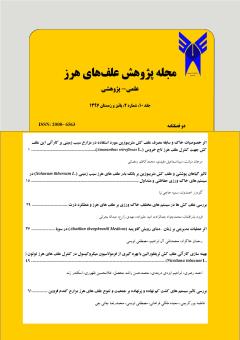کاربرد پسرویشی اختلاط علف¬کش¬های آترازین و توفوردی ام. سی. پی. ای در مدیریت تلفیقی علف¬های هرز ذرت علوفه¬ای (Zea mays)
محورهای موضوعی : پژوهش علف های هرز
سید داوود سجادیان
1
,
محمد حسن راشد محصل
2
,
کمال حاج محمدنیا قالی باف
3
![]()
1 - دانشجوی دکتری گروه اگروتکنولوژی، دانشکده کشاورزی، دانشگاه فردوسی مشهد، مشهد، ایران
2 - استاد گروه اگروتکنولوژی، دانشکده کشاورزی، دانشگاه فردوسی مشهد، مشهد، ایران
3 - استادیار گروه اگروتکنولوژی، دانشکده کشاورزی، دانشگاه فردوسی مشهد، مشهد، ایران
کلید واژه: کنترل شیمیایی, کنترل مکانیکی, کولتیواتور, مخلوط علف¬کش¬ها, مدیریت علفهای هرز,
چکیده مقاله :
این پژوهش به¬صورت اسپلیت فاکتوریل در قالب طرح بلوک¬های کامل تصادفی با سه تکرار در مزرعه آموزشی و تحقیقاتی دانشگاه فردوسی مشهد در سال 1400 انجام شد. عامل اصلی شامل کولتیواتور در سه سطح: بدون کولتیواتور، یک¬بار و دو بار کولتیواتور و عوامل فرعی شامل ترکیب تیماری کاربرد پس¬رویشی علف¬کش¬های آترازین (WP 80%) با سه سطح صفر، یک و دو کیلوگرم در هکتار و توفوردی ام. سی. پی. ای (SL 5/67%) با سه سطح صفر، 750/0 و 5/1 لیتر در هکتار بهصورت فاکتوریل بود. بر اساس نتایج حاصله، حساس¬ترین علف¬های هرز پهن¬برگ به توفوردی ام. سی. پی. ای سلمه و توق بودند، در صورتی که علف¬های هرز خرفه، تاجخروس رونده، تاجخروس ریشه قرمز و داتوره حساسیت کمتری داشتند. در بین علف¬های هرز باریکبرگ نیز سوروف نسبت به آترازین حساس بود، در صورتی که علف¬های هرز دمروباهی کشیده و علف خرچنگ مقاومت ذاتی داشتند. اثر کولتیواتور، آترازین و توفوردی ام. سی. پی. ای بر وزن خشک ذرت در سطح یک درصد معنی¬دار بود، بهطوری که با افزایش تعداد کولتیواتور در هکتار وزن خشک ذرت افزایش یافت. آترازین به مقدار یک کیلوگرم در هکتار موجب افزایش معنی¬دار وزن خشک ذرت شد، در حالی که افزایش مقدار آترازین کاهش وزن خشک کل محصول را باعث شد. افزایش مقدار مصرف توفوردی ام. سی. پی. ای نیز وزن خشک کل ذرت را بهصورت معنی¬داری افزایش داد. در مجموع، کاربرد دو بار کولتیواتور، یک کیلوگرم آترازین و 5/1 لیتر توفوردی ام. سی. پی. ای در هکتار، به ترتیب موجب 21، 29 و 42 درصد افزایش در وزن خشک کل ذرت نسبت به تیمار شاهد شد.
Weed control in corn conducted with various methods including chemical and mechanical or integrated of two mentioned methods. Atrazine is basic herbicide for many weeds control programs in USA. Atrazine is herbicide with good contact effect can be used as a post-emergence herbicide in corn. 2,4-D yet is an important part of weed control programs in the world and effective for many broad leaves weed control. Herbicide’s mixture can broaden weed control spectrum in crop such as corn. Herbicide’s mixture and cultivation caused effective weed control and reduce amount of herbicides application. In order to evaluate mixing and post emergence application of Atrazine and 2,4-D M.C.P.A on corn silage an experiment conducted in split plot factorial arranged in randomized complete block with three replication. Main factor was cultivation with three level 0, 1 and 2 time per hectare (respectively C1, C2 and C3) and factorial combination of Atrazine and 2,4-D M.C.P.A as a sub factor including Atrazine Wetable powder (%80 active ingredient) with 0, 1 and 2 kg per hectare (respectively A1, A2 and A3) and 2,4-D M.C.P.A soluble liquid (%67.5 active ingredient) with 0,.75 and 1.5 lit per hectare (respectively T1, T2 and T3), petroleum oil with Ghazal Shimi brand as an additive mixed with spraying solution as much as 1 liter per hectare in treatments with Atrazine to increase contact effect of Atrazine post emergence application. In this experiment Cocklebur and Common Lambs quarter were more sensitive broad leaves weeds to 2,4-D M.C.P.A but Purslane, Prostrate pigweed amaranth, red root pigweed and Jimsonweed were less sensitive. In narrow leaves weeds (grasses) Barnyard grass was sensitive to atrazine whereas Foxtail and Crab grass were tolerated. Effect of Cultivation, Atrazine and 2,4-D M.C.P.A on corn dry matter were significant (α=1%), so that one kilogram Atrazine per hectare caused significant dry matter increase in corn. Increase Atrazine application to two kg per hectare caused decrease in corn dry matter but was more than zero Atrazine and not significant. With increase 2,4-D M.C.P.A application from 0.75 to 1.5 liter per hectare, corn dry matter increased significantly. Interactions between cultivation, Atrazine and 2,4-D M.C.P.A were not significant. In simple effects of treatments, two-time cultivator (C2), one kilogram Atrazine (A2) and 1.5 liter 2,4-D M.C.P.A per hectare caused 21, 29 and 42 percent increase in corn dry mater, respectively.


